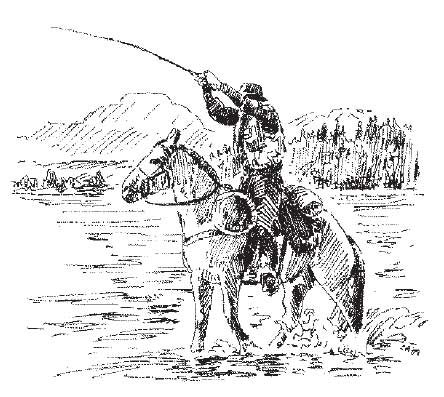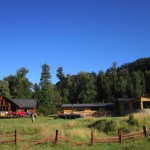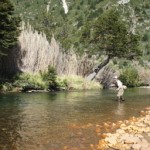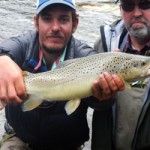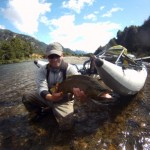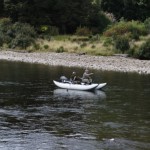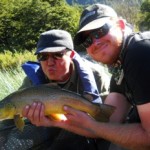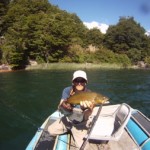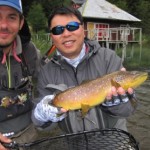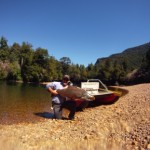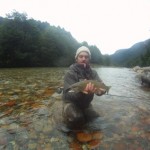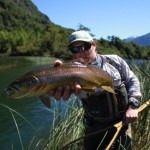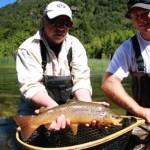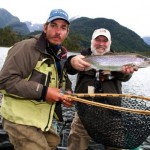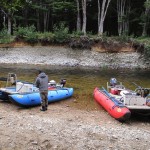Patagonia Angling Report
January 20th 2013
The Angling Report is a well respected source of independent reviews on fly fishing lodges. This report is worth reading. To respond to the authors comments about traveling distances, we have built a remote camp at the confluence of Rio Toki and Rio Manihualis. We aim to please and I can proudly say that the author of this piece is currently at our lodge for his third visit.
Story courtesy of The Angling Report , June 2009
DATELINE: CHILE
Honor Roll Report
This Patagonian Lodge
Is Remote & Memorable(Editor Note: We love it when subscribers check in with reports like the one that follows on a remote lodge we never heard of. Subscriber John W Harrison filed the report, and we are putting him on our Subscriber Honor Roll for taking the time and effort to let the rest of us know about this place. His Honor Roll Fishing Cap is already in the mail… ).
Picture this if you can: A remote lodge north of Coyhaique that can be reached only by jet boat. Called Picacho Lodge, it is located on a river that flows through an out-of-way valley so steep it is practically uninhabited. Need I say that my group and I saw no other boats or fishermen during a recent six-day stay? The fishing, of course, was memorable.
Our arrangements were ably handled for us by Austin Hepburn of Uncommon Ventures (610-688-4335) and Picacho Lodge manager Christian Effa.
We had considerable reservations about visiting Picacho in view of its remote location, and reports of trout kills from sea lion activity in this area. These gentlemen were extremely honest, forthcoming and helpful with all our pre-trip questions, however, and in hindsight all of our concerns were groundless.
Particularly helpful was their willingness to meet our party of six at the Martin Pescador Lodge near La Junta (where we were fishing the week before) and transport us by road/jet boat directly to Picacho Lodge, avoiding the hassle of local airports and giving us a full six days of fishing. Normally, they would meet guests either at La Junta or Balmaceda airports. Instead, four pontoon jet boats met us at
the end of the road for a 20-minute journey down the Picacho River.The appearance and location of this lodge are breathtaking: three modern log buildings overlooking a wide bend of the river and a superb mountain vista. Apart from one other log home, we saw no other signs of human habitation during our seven days on the river. The main lodge has a large sitting area with log fire, a dining area and bedrooms off to the
side. Accommodations consist of one large double en-suite bedroom and four single rooms sharing two shower/ bathrooms. This was ideal for our party of six.The staff were extremely attentive and included three guides, two cooks (both qualified at the Santiago Culinary Institute) and two caretakers who prepared the boats each morning and carried all our tackle down to the river. A particularly nice feature here was a wood-fired hot tub on the deck where one could relax and enjoy the magnificent views with a glass of wine after each day’s fishing.
As for meals, breakfast was a-lacarte. A hot lunch was prepared each day riverside by our guide, including an excellent bottle of wine if we wished. Dinner, which was always preceded by various hors d’oeuvres, was a three-course event every night.
Our last night we had a traditional asado that was quite outstanding considering the remoteness of the lodge.
The three Chilean guides were exceptional young men, all University educated and fluent in English, and with qualifications in ecology. They were keenly aware of the flora and fauna we saw, and they had a firstclass knowledge of the lakes and rivers we fished. Although we may have fished with more experienced guides, we all agreed we had never had such friendly, attentive and enthusiastic guides so committed to making our fishing trip an enjoyable experience.
We used 6- and 7-weight rods, floating lines and big dry files, switching to caddis in the evenings and occasionally small streamers in the fast water. Each of our six days of fishing was a different but equally enjoyable experience.
Day 1 we traveled down the Picacho River and hiked about half a mile to a series of small, reedy lakes, some of which had not been fished since the previous year. It was cool with rain most of the day, but we took some nice browns and rainbows up to 20 inches, all on dry flies.Day 2 we floated to the confluence of Rio Roosevelt and then down to Lago Copa. It rained all day except when the guide ordered it to stop while he grilled steaks for lunch. We had action despite the rain, mainly on dry flies, but occasionally with small olive streamers. Lago Copa itself has few trout and is slowly recovering after sea lions entered the lake and did a lot of damage a few years ago.
Day 3 was one of the most spectacular days of dry fly brown trout fishing my partner Steve and I had ever had. That day we made a fairly grueling 45-minute hike to Lago Roosevelt to begin a float at the outflow of the lake. Almost immediately, an amazing mayfly hatch began and lasted for almost four hours. Large brown trout (most of them 18- to 20- inchers) were slashing at mayflies all across the river, in both directions as far as we could see. Any dry fly dropped close to a rising fish was engulfed. These were powerful, beautifully colored fish. After lunch, we tried the reed beds around the lake, but the wind came up and put the fish down. We had only occasional fish for the rest of the afternoon.
Day 4 was the best weather of the week, and we cast all day to rising browns and rainbows on some beautiful private stretches of the Rio Toqui. As the sun got higher, a side-cast under an overhanging bush usually produced a splendid brown. A highlight for me was watching a group of eight gauchos and their dogs drive 200 or so head of cattle across the river just upstream of me. They all waved and smiled, as if they knew that the feet of the cattle would stir up an absolute smorgasbord of nymphs and worms. Indeed, the whole river came alive with trout as this water reached me. I think Steve and I caught 40 to 50 good trout that day, several over 20 inches, most on dry flies.
Day 5 was another cool and rainy day. We spent it on the small and technically difficult Rio Emperador Guilermo on our journey back to Coyhaique. This is a shallow, fast river, flowing through pampas-like fields. It has a remarkable population of browns and rainbows for such a small river. We caught a fish on almost every cast, with lot of those measuring six to 12 inches. However, I did catch one of the most beautifully colored 24-inch brown trout I have ever held.
Our guide, Geronimo, then drove us to Coyhaique, where (at no extra cost) we were accommodated in a delightful small hotel and taken out for a splendid meal. The next morning we were driven to Balmaceda airport to begin our journey home.
One thing fishermen headed to Picacho should be aware of is that although the lodge sits right on the Picacho River this stream contains only small trout in the vicinity of the lodge. Quality fishing is some distance from the lodge and each day commenced with a long (40- to 75-minute) river, road or hiking trip to get to good fishing spots. This was fine on sunny day, but was increasingly tiresome on cold, wet days.
The folks at Picacho lodge told us they are thinking of establishing spike camps on the Toqui and Picaflora rivers to allow for overnight stays. This would reduce traveling time for those who want this kind of experience.
The total cost of our trip was $3,000 per person. That included all meals, drinks, shared guides and airport transfers at the start and finish of the trip. – John W. Harrison.
The Angling Report
June 2009

